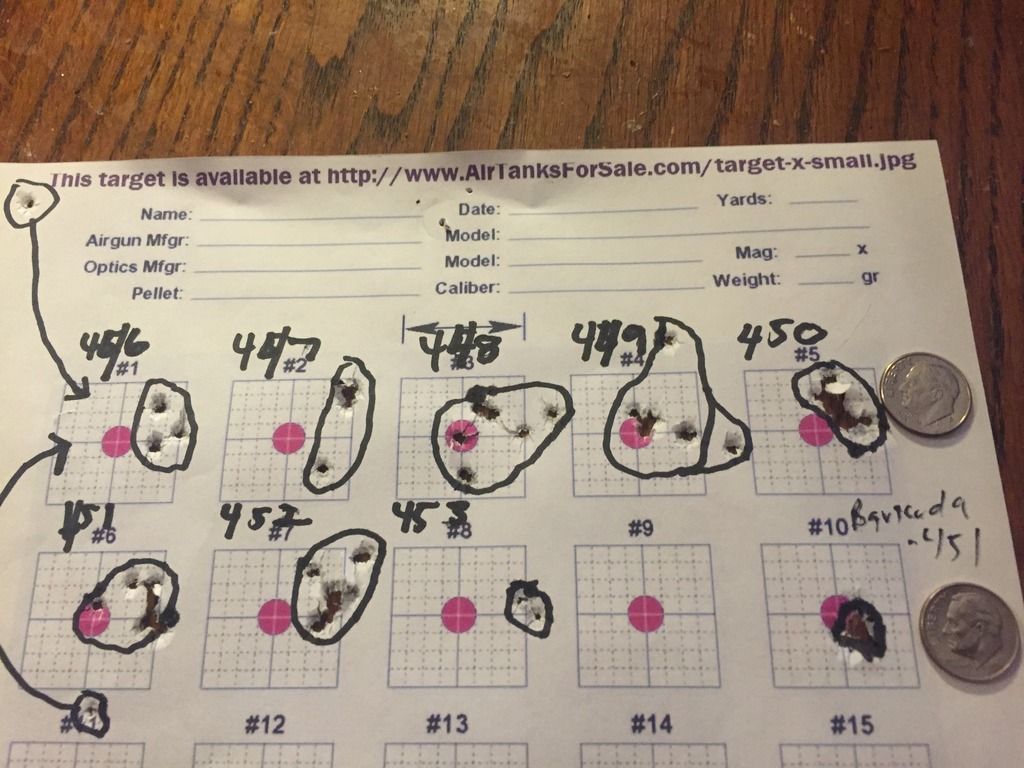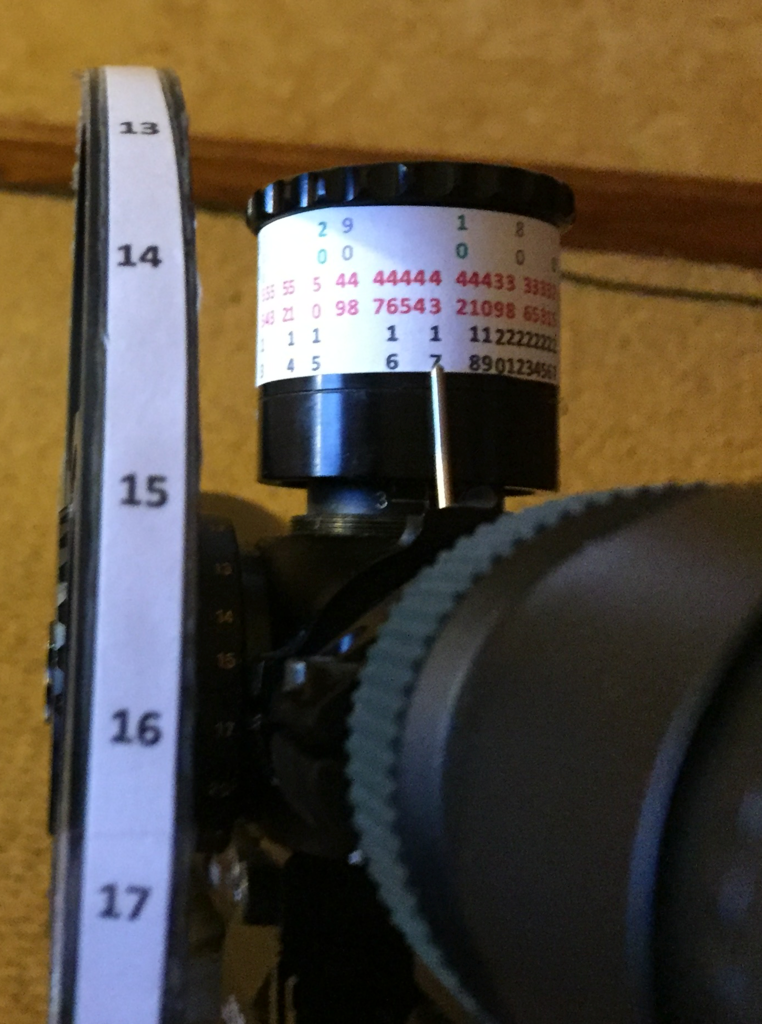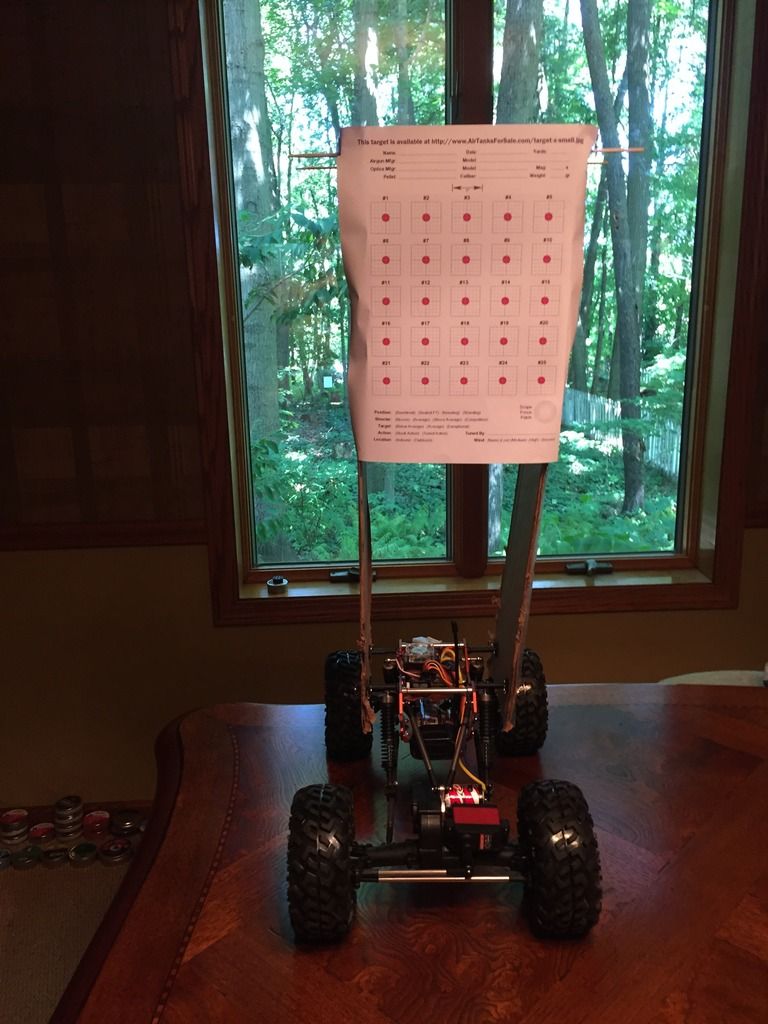"sharroff"Zebra,
Yes, my air rifles are all one hole shooters at 30 yards. Here is an old .177 target where I was doing pellet head size testing at 50 yards. With 4.50 or .451 sized pellets my field target guns shoot into like 1/4" (AZ Steyr) and 3/8" (AZ CR-X) at 50 yards. (the size of the red dots is 1/4). The Airwolf MCT .22 and RAW HM 1000x .30 stack pellets at 50 yards as well.

Those numbers above are the pellet head sizes from .446 to .453. See how open the .446 group is? So, to get one hole I need .450 or .451 pellets. If I shot from the tin (those are all from the same tin). I'd get 'fliers" and open groups.
If I did have a gun that had POI variation at that 30 yards, I'd be working on pellet sizing/weight/shape/brand testing -like the above - to get rid of the variation (if I were target shooting) Then I'd give away all the pellets that didn't shoot well (like I just did here last week) If I could not get rid of the variation, depending on the POI spread, I'd shoot groups to find the average POI and use that. The bigger the variatio the more pellets I'd use per group.
Lol, that is no suduko puzzle, and there is no math. That tape wraps around my elevation turret like in my avatar. Look at the far left bottom of the scope tape. That black 10 is 10 yards, then to the right, 11 yards, and so forth. The first red number on the far right is 29 yards right above the black 27 yard. So, turn the elevation turret so the pointer lines up with the scope tapes target yardage and the cross hairs will be exactly where the pellet will hit.
The mil dots over and under will look the same because they have to be in order to be effective tools for compensating for distance. The only advantage to having the scope zeroed at the apex for mil dots is everything is hold over and there is no hold under numbers to remember. And you'll also get yardage pairing that way. Looking at my tape, the hold over for 11 and 63 yards is the same as is 13 and 55, 16 and 46, 18 and 41, then all the numbers line up. One would only have to memorize ten or so combos to use hold over effectively from 11 to 63 yards on my gun.
And in my case from 18 to 41 yards I know that I wouldn't need much hold over at all. 1/4 low at 18, on at 28, and 1/2 low at 41 is about all I'd need for backyard type shooting.
The big advantage to doing it my way (dialing) is that it doesn't matter if my scope is set at 10X or 50X or somewhere in between. The cross hairs will still be exactly on target. With mildots and hold over, they are only accurate at the distance the scope was calibrated/sighted at. On a fixed power scope, no issue. On variable power, which most of us have, the mil dots are calibrated typically at the lowest power. That's why chair gun / strelok asks for the minimum magnification, calibration magnification, and current magnification.
Let's use a real example. If I were aiming at a squirrel 53 yards away, my gun with its current settings and scope set at 10x I would hold over by 1 mil dot and be exactly on target. If my scope were at 20x, I'd now need to hold 2 mil dots over to hit the same target. At 30x, it's now 3 mildots. At 40x 4 mil dots and at 50x 5 mil dots. So I'd not only have to know the table for pellet drop, I'd have to be doing the math to get the mil dot holding right based on my current scope magnification (or carry a phone with Strelock). I'd rather know the yardage, turn the turret, center the cross hairs, and hit the target regardless of my magnification. Mil dots also work well when you are consistently shoot a target of the same size and can use the mildots to get an approximate distance to the target (deer, man, etc). For example something that is 2 mil dots high at 50 yards is only going to be 1 mil dot high at 100 yards (given the same magnification again). I don't think you'd find many military snipers using that approach though; given enough time for their shot, they are turret twisters.



